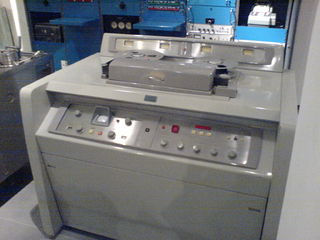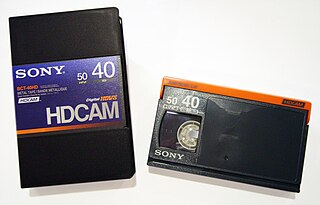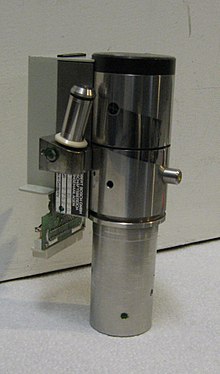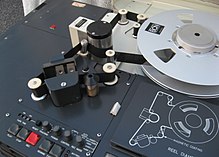
Digital video is an electronic representation of moving visual images (video) in the form of encoded digital data. This is in contrast to analog video, which represents moving visual images in the form of analog signals. Digital video comprises a series of digital images displayed in rapid succession, usually at 24, 30, or 60 frames per second. Digital video has many advantages such as easy copying, multicasting, sharing and storage.

Video is an electronic medium for the recording, copying, playback, broadcasting, and display of moving visual media. Video was first developed for mechanical television systems, which were quickly replaced by cathode-ray tube (CRT) systems, which, in turn, were replaced by flat-panel displays of several types.
A hard disk recorder (HDR) is a system that uses a high-capacity hard disk to record digital audio or digital video. Hard disk recording systems represent an alternative to reel-to-reel audio tape recording and video tape recorders, and provide non-linear editing capabilities unavailable using tape recorders. Audio HDR systems, which can be standalone or computer-based, are typically combined with provisions for digital mixing and processing of the audio signal to produce a digital audio workstation (DAW).

Ampex Data Systems Corporation is an American electronics company founded in 1944 by Alexander M. Poniatoff as a spin-off of Dalmo-Victor. The name AMPEX is a portmanteau, created by its founder, which stands for Alexander M. Poniatoff Excellence. Ampex operates as Ampex Data Systems Corporation, a subsidiary of Delta Information Systems, and consists of two business units. The Silicon Valley unit, known internally as Ampex Data Systems (ADS), manufactures digital data storage systems capable of functioning in harsh environments. The Colorado Springs, Colorado, unit, referred to as Ampex Intelligent Systems (AIS), serves as a laboratory and hub for the company's line of industrial control systems, cyber security products and services and its artificial intelligence/machine learning technology.
Betacam is a family of half-inch professional videocassette products developed by Sony in 1982. In colloquial use, Betacam singly is often used to refer to a Betacam camcorder, a Betacam tape, a Betacam video recorder or the format itself.

A video tape recorder (VTR) is a tape recorder designed to record and playback video and audio material from magnetic tape. The early VTRs were open-reel devices that record on individual reels of 2-inch-wide (5.08 cm) tape. They were used in television studios, serving as a replacement for motion picture film stock and making recording for television applications cheaper and quicker. Beginning in 1963, videotape machines made instant replay during televised sporting events possible. Improved formats, in which the tape was contained inside a videocassette, were introduced around 1969; the machines which play them are called videocassette recorders.

A tape head is a type of transducer used in tape recorders to convert electrical signals to magnetic fluctuations and vice versa. They can also be used to read credit/debit/gift cards because the strip of magnetic tape on the back of a credit card stores data the same way that other magnetic tapes do. Cassettes, reel-to-reel tapes, 8-tracks, VHS tapes, and even floppy disks and early hard drive disks all use the same principle of physics to store and read back information. The medium is magnetized in a pattern. It then moves at a constant speed over an electromagnet. Since the moving tape is carrying a changing magnetic field with it, it induces a varying voltage across the head. That voltage can then be amplified and connected to speakers in the case of audio, or measured and sorted into ones and zeroes in the case of digital data.
A recording head is the physical interface between a recording apparatus and a moving recording medium. Recording heads are generally classified according to the physical principle that allows them to impress their data upon their medium. A recording head is often mechanically paired with a playback head, which, though proximal to, is often discrete from the record head.

U-matic or 3⁄4-inch Type E Helical Scan or SMPTE E is an analogue recording videocassette format first shown by Sony in prototype in October 1969, and introduced to the market in September 1971. It was among the first video formats to contain the videotape inside a cassette, as opposed to the various reel-to-reel or open-reel formats of the time. The videotape is 3⁄4 in (19 mm) wide, so the format is often known as "three-quarter-inch" or simply "three-quarter", compared to open reel videotape formats in use, such as 1 in (25 mm) type C videotape and 2 in (51 mm) quadruplex videotape.

1-inch Type C Helical Scan or SMPTE C is a professional reel-to-reel analog recording helical scan videotape format co-developed and introduced by Ampex and Sony in 1976. It became the replacement in the professional video and broadcast television industries for the then-incumbent 2–inch quadruplex videotape open-reel format. Additionally, it replaced the unsuccessful type A format, also developed by Ampex, and primarily in mainland Europe, it supplemented the type B format, developed by the Fernseh division of Bosch.

HDCAM is a high-definition video digital recording videocassette version of Digital Betacam introduced in 1997 that uses an 8-bit discrete cosine transform (DCT) compressed 3:1:1 recording, in 1080i-compatible down-sampled resolution of 1440×1080, and adding 24p and 23.976 progressive segmented frame (PsF) modes to later models. The HDCAM codec uses rectangular pixels and as such the recorded 1440×1080 content is upsampled to 1920×1080 on playback. The recorded video bit rate is 144 Mbit/s. Audio is also similar, with four channels of AES3 20-bit, 48 kHz digital audio. Like Betacam, HDCAM tapes were produced in small and large cassette sizes; the small cassette uses the same form factor as the original Betamax. The main competitor to HDCAM was the DVCPRO HD format offered by Panasonic, which uses a similar compression scheme and bit rates ranging from 40 Mbit/s to 100 Mbit/s depending on frame rate.

1-inch Type A Helical Scan or SMPTE A is a reel-to-reel helical scan analog recording videotape format developed by Ampex in 1965, that was one of the first standardized reel-to-reel magnetic tape formats in the 1–inch (25 mm) width; most others of that size at that time were proprietary. It was capable of 350 lines.

2-inch quadruplex videotape was the first practical and commercially successful analog recording video tape format. It was developed and released for the broadcast television industry in 1956 by Ampex, an American company based in Redwood City, California. The first videotape recorder using this format was built the same year. This format revolutionized broadcast television operations and television production, since the only recording medium available to the TV industry until then was Motion picture film.

Sony HDVS is a range of high-definition video equipment developed in the 1980s to support an early analog high-definition television system thought to be the broadcast television systems that would be in use today. The line included professional video cameras, video monitors and linear video editing systems.
Time base correction (TBC) is a technique to reduce or eliminate errors caused by mechanical instability present in analog recordings on mechanical media.
International Video Corporation, or IVC, was a California company with large European operations that manufactured a number of models of middle to high-end video tape recorders, or VTRs, for industrial and professional use in the US, alongside a range of digital video Time Base Correctors and Special Effects units designed and manufactured in the UK. Their products were very popular in the industrial, scientific, research, medical, education, and institutional markets from the late 1960s through the 1980s.
The Fernseh AG television company was registered in Berlin on July 3, 1929, by John Logie Baird, Robert Bosch, Zeiss Ikon and D.S. Loewe as partners. John Baird owned Baird Television Ltd. in London, Zeiss Ikon was a camera company in Dresden, D.S. Loewe owned a company in Berlin and Robert Bosch owned a company, Robert Bosch GmbH, in Stuttgart. with an initial capital of 100,000 Reichsmark. Fernseh AG did research and manufacturing of television equipment.

D6 HDTV VTR is SMPTE videocassette standard. A D6 VTR can record and playback HDTV video uncompressed. The only D6 VTR product is the Philips, now Thomson's Grass Valley's Media Recorder, model DCR 6024, also called the D6 Voodoo VTR. The VTR was a joint project between Philips Digital Video Systems of Germany and Toshiba in Japan. The tape deck module was designed and made by Philips in Weiterstadt, Germany, and the digital processor module designed and made by Toshiba. Since there is no data compression, after 20 tape copies of multi generations there is no noticeable loss of quality. As a very high-end, costly system about 70 were sold to high-end post houses from about 2000 to 2005. The VTR had a data record option. The data module could record and play back 2k DPX files at 6 frames per second over a HIPPI connection. The VTR came in a data only model, or with a switch module, so the record deck could be used for both video and data recording. The tape deck was also sold stand alone as a giga bit recorder to record and playback raw data. Toshiba made the video tape for the VTR. The high price of the video tape limited the use of the VTR.

IVC 2 inch Helical scan was a high-end broadcast quality helical scan analog recording VTR format developed by International Video Corporation (IVC), and introduced in 1975. Previously, IVC had made a number of 1 inch Helical VTRs. IVC saw a chance to make a VTR that would have the quality of the then-standard 2 inch Quadruplex videotape format but with the advantages of helical scan. They then developed a VTR using this technology, the IVC Model 9000.
Electronovision was a process used by producer and entrepreneur H. William "Bill" Sargent, Jr. to produce a handful of motion pictures, theatrical plays, and specials in the 1960s and early 1970s using a high-resolution videotape process for production, later transferred to film via kinescope for theatrical release.




















